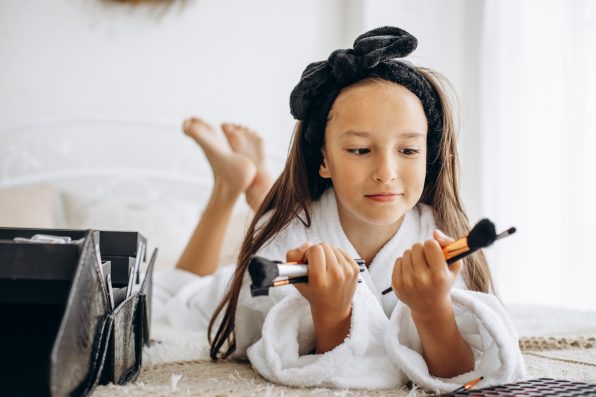Social Media Trends Are Pushing Tweens To Try Out Skincare Routines Sooner Than Ever: Here’s How To Navigate The Craze And Discern When It’s Best To Introduce Your Kids To Healthy Skin Habits

In a world where social media platforms like TikTok have become a hub for beauty gurus worshipped by younger generations, it’s not surprising to see tweens getting curious about skincare routines earlier than ever.
And while these platforms can be a treasure trove of information, they also raise critical questions for parents. For instance, when is the right age to introduce skincare to children, and what products are appropriate?
The Social Media Influence: A Double-Edged Sword
TikTok has transformed how young people engage with beauty and skincare. This platform is brimming with skincare advice, routines, and product recommendations, spurring an early interest among tweens.
But, despite some of this information being educational, it’s still crucial for parents to guide their children and help them discern what practices are beneficial versus harmful or simply unnecessary for their young skin.
The Right Time To Start Skincare
Now, no two kids are alike, but puberty will bring about significant skin changes among most adolescents– making ages 12 to 14 ideal for introducing a basic skincare regimen.
This period typically marks the beginning of concerns such as acne, oily skin, or dry patches.
However, it’s important to remember that each child’s skin is unique, and a one-size-fits-all approach simply doesn’t work in skincare.

Petro – stock.adobe.com – illustrative purposes only, not the actual child
The Basics Of A Tween Skincare Routine
A simple, gentle skincare routine is the best way for children to get started. This might include washing with a mild cleanser, applying a lightweight, non-comedogenic moisturizer afterward, and, lastly, topping off with some sunscreen.
It’s also advisable to steer clear of products with strong, active ingredients, such as retinoids or high concentrations of salicylic acid, which might be too harsh for young skin.
Incorporating Healthy Skin Habits
Beyond products, it’s essential that you teach your kids about healthy skin habits, too. This will include understanding their skin type, learning about the importance of hydration, and understanding the impact that diet and exercise can have on skin health.
Plus, encouraging routines– like washing their face after sweating and using clean towels– can make a significant difference.
How To Navigate The “Hype”: Understanding Marketing Versus Needs
It can be tough for children to discern between what is an honest product review on social media and a sponsored partnership or advertisement.
Heck, it’s tough for even adults to know the difference sometimes.
So, in a world where marketing can often be mistaken for necessity, guiding your children to understand their actual skin needs is vital.
This will involve deciphering what’s a trend and what’s actually beneficial for their skin type. It’s also an opportunity to discuss the influence of advertising and the importance of self-acceptance.
Sensitive Skin Considerations
Lastly, it’s important to note that, for children with sensitive skin or conditions like eczema, the approach to skincare needs to be even more cautious.
In these cases, consulting with a dermatologist before starting any skincare routine is best. Hypoallergenic and fragrance-free products are often recommended for sensitive skin.
Sign up for Chip Chick’s newsletter and get stories like this delivered to your inbox.
More About:Parenting





